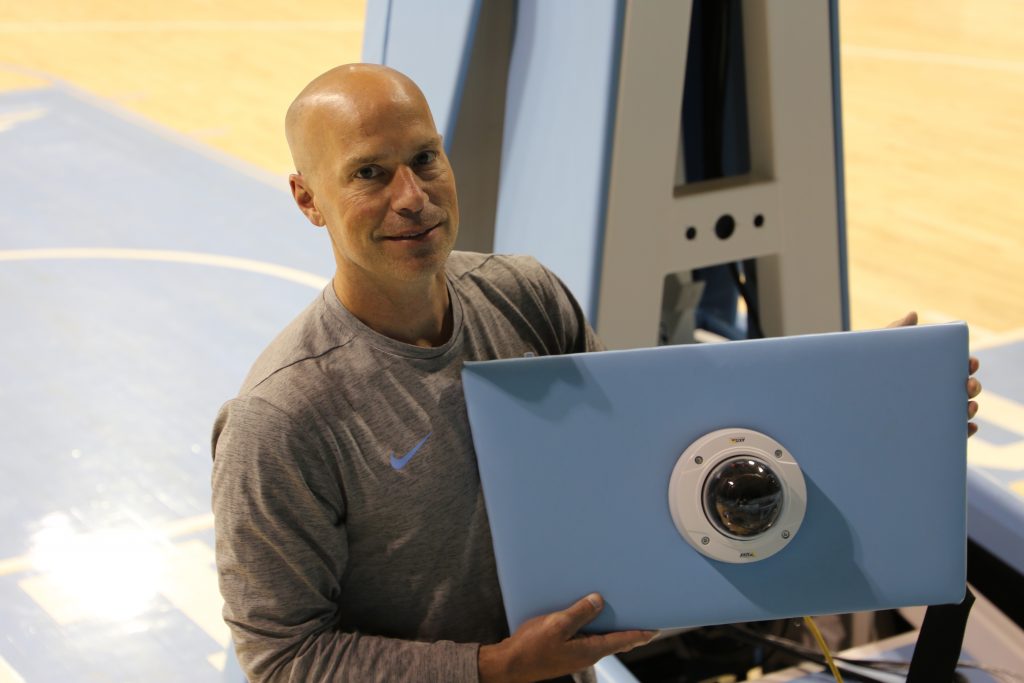
Internet protocol cameras have proven to be tremendously useful on Carolina’s athletic fields and courts.
Over the past three years, ITS has more than quadrupled the number of these internet protocol (IP) cameras deployed for UNC Athletics in its venues.
In 2016, the varsity volleyball team got the first taste of the revolutionary technology when Athletics teamed up with ITS User Support & Engagement to install six IP cameras in Carmichael Arena.
The cameras quickly became a staple for the volleyball team. “We use the IP cameras every day for our practices and games,” said Head Volleyball Coach Joe Sagula.
The IP cameras, which automatically upload multi-angle footage to an online server for access and distribution, have since been added to most of UNC Athletics’ facilities.
Growing technology
“Our goal is for all athletic facilities to have these cameras,” Tom Livers said in a May interview while still with ITS as Team Lead for Athletics IT Services. In July, Athletics began supporting its own IT needs after years of outsourcing to ITS. Livers now works directly for Athletics. “That way, for example, if the soccer team wants to practice indoors one day, they have access to the practice footage from a different location.”
Since 2016, sports teams including baseball, softball, diving, fencing, field hockey, soccer and tennis have joined volleyball in using the IP cameras. “There are currently around 50 cameras and we’re still adding more, the new soccer facility will get at least eight,” Livers said in May.
SideLine Scout, a recently added video replay system, is giving the installed IP cameras a technology boost. This system converts the incoming video stream into clips, which are distributed to connected iOS devices.
This system enables coaches, like Coach Sagula, to instantly select clips of footage to show to players during practice. The field hockey team, which is currently equipped with six cameras, streams footage onto the jumbotron to review with players during practice.
IP cameras have multiple uses
Initially installed to enable more accessible access of practice footage for coaches, the IP cameras have since come to serve multiple functions. In addition to doubling as security cameras, they capture footage that isn’t always seen, and can be used by GoHeels Productions.

GoHeels Productions is a unit within UNC Athletics that produces live broadcasts of Carolina sporting events to distribute to ESPN, GoHeels.com and on the GoHeels Productions’ YouTube and Twitter platforms.
Livers used to worry that each Carolina sports team would rely on multiple different cameras and servers for their needs, making it difficult for ITS to keep track of and provide support for Athletics.
“The IP cameras have multiple uses, including security, instant replay and footage for coaching, which addresses the fear of multiple cameras,” Livers said.
In addition to being multi-use, the IP cameras are providing better quality game footage to Carolina sports fans. “IP cameras have the processing power to stream to apps, like streaming the NCAA tennis matches to YouTube this past season,” Livers said.
Legacy of constant change
By the end of August, all UNC sports facilities are scheduled to have up-to-date IP camera software.
“Softball are volleyball are currently demoing the cameras, Carmichael is done, we’re finishing the Smith Center and tennis this summer, and the new soccer and lacrosse facility will be done in the next month or so,” Livers said in May.
During his more than 30 years of coaching at Carolina, Coach Sagula has seen many changes in technology.
“We had VCRs with a two-hour footage limit, then cassette tapes, and then cameras with SD cards,” Sagula said.
The coach reminisced on times when someone forgot to cut the camera on, or the occasions that a stray volleyball would knock them over. The IP cameras, stationed in six angles around the arena, have completely eliminated these concerns.
“It’s amazing to see how far we’ve come, but also the advances that will be made in the future,” Sagula said.
